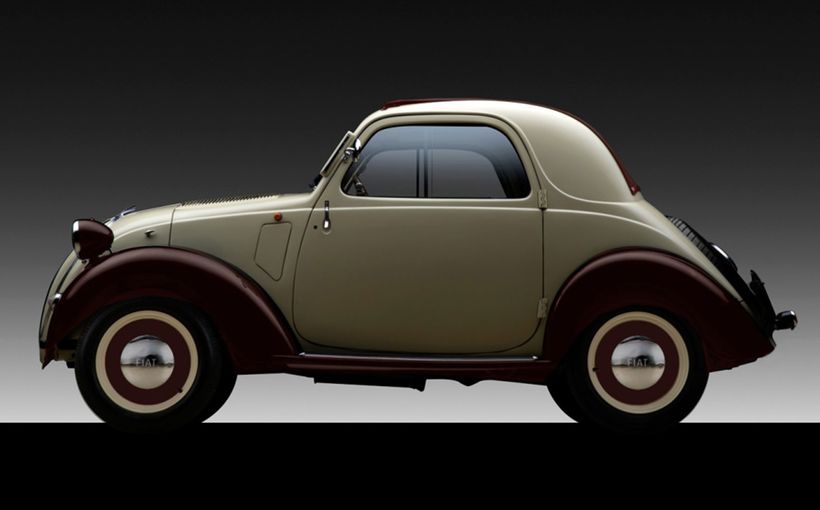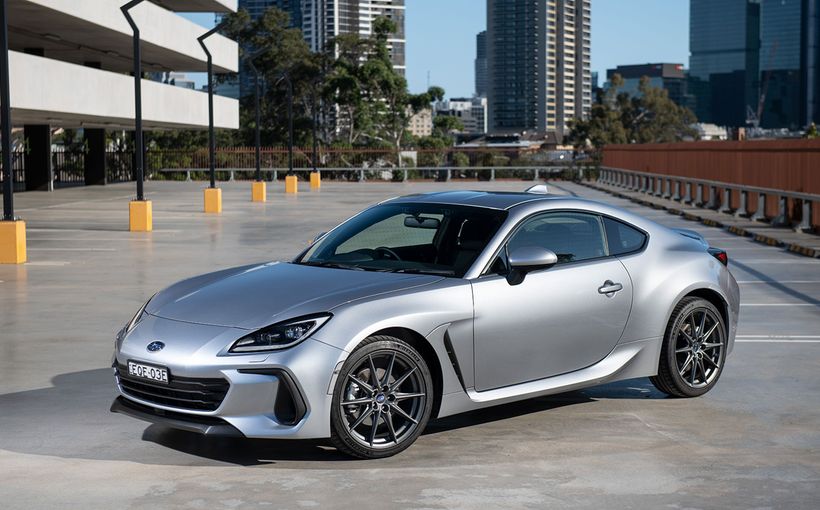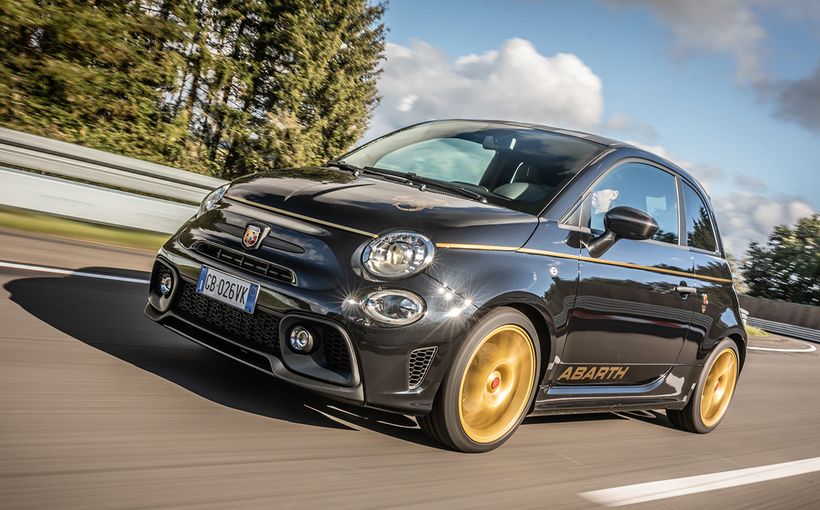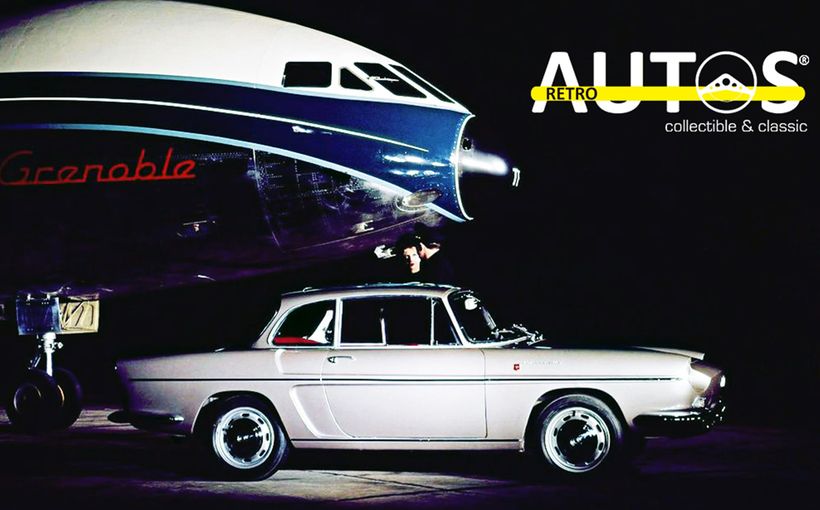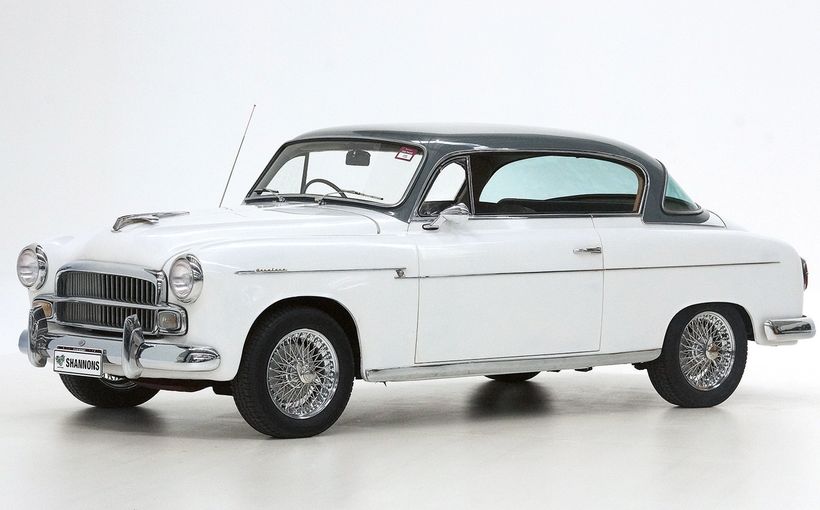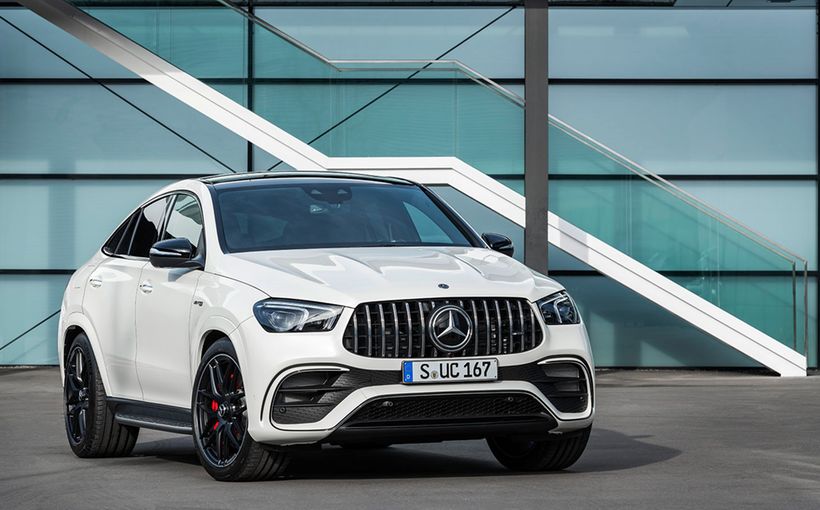1966-71 Fiat 850 Sport Coupe: Italian Super Mouse Bred for Cool Alley Cats

The earliest version of the Fiat 850 Coupe was rare new in Australia and even more so today as sales were limited by a steep introductory price. Many claim that the original’s simplicity and balance that provide few clues to its tiny size make it a 1960s style icon. (Photo from onlycarspictures.com)
It took the Italians to engineer a mouse-like runabout for scurrying through the narrow, hilly streets of Sydney’s Balmain or Melbourne’s Richmond and make each drive feel like a personal Targa Florio. Launched locally in July 1966 at a heady $2435, the baby Fiat coupe only became a serious contender when the price was slashed to just $2198 as Fiat took over local distribution in 1967. Until it was replaced by the equally engaging front-drive 128 range in 1971, the Fiat 850 Sport Coupe held its own as the most sophisticated and desirable expression of the rear-engined baby runabout formula.

While setting new standards in cabin and luggage space for a sub-one litre rear-engined small car, the Fiat 850 lost some of the charm of Fiat’s earlier small cars. Because the basics were so flexible, it created a blank canvas for a wide range of special bodies from the factory and coachbuilders for an 850 charm offensive. High import price limited local 850 sedan sales but fun-to-drive factor compensated. Local cars were Italian Super spec hence listed sometimes as 850S.
The Fiat 850S sedan was the first small Fiat to be marketed in Australia as the fastback 850 alternative to the Mini, Hillman Imp and VW Beetle from March 1965. It replaced the milestone Fiat 600 that had served Fiat since 1955. Fiat was forced to generate extra local cachet by highlighting the roofline of the 850’s more generic three box shape as a plus over its cute and much cheaper rivals.
Back in Italy, the Fiat 850 didn’t need to be much more than an evolution of the Fiat 600, itself a larger variation of the rear-engined Bambino Fiat 500 formula. Both of these rear-engined models covered the niche defined by the original Fiat 500 Topolino or Mickey Mouse car. All the new Fiat 850 had to do was establish a more convincing line between a city runabout and a proper car except it couldn’t do so in Australia. As an import, it was not only priced higher than the Mini 850, it demanded a further premium over the more powerful Mini Deluxe, which took it out of the runabout category.

Clever Fiat packaging and the 850’s sophisticated mechanicals defined the perfect starting point for a wide range of sports models. Note the double-jointed semi-trailing arm rear suspension and short rear overhang for a rear engine model. (Photo from ranwhenparked.net)
The Fiat 850 Coupe version had the potential to change this but not at $2435, a massive $700 hike over the sedan. The 1967 price cut changed that overnight and positioned it in a sweet spot where it was priced lineball against the baby Mazda 1000 Coupe and Honda S600, both of which the Fiat could dispatch with ease.
Its only real threat was the Hillman Imp GT, a more powerful rival with a similar rear engine layout and a compelling $1750 locally assembled price, the same figure as the local Fiat 850S sedan. Despite its on paper advantages and sharp pricing, the Imp GT was no match for the coupe in the desirability stakes nor could it match the baby Fiat’s performance or economy.

The Sunbeam Stiletto version of the Hillman Imp was one of the few global models that could challenge the Fiat 850 Coupe. Its Chevrolet Corvair-inspired styling, sporty cabin and advanced engine were more than a match but the Fiat didn’t look like a version of a cheaper car. Although the Imp/Stiletto’s rear suspension matched the Fiat’s, its front end generated some odd wheel angles.
Had Chrysler decided to assemble the Sunbeam Stiletto coupe version of the Imp, the Fiat coupe might have faced its only real local competition. Road tests at the time suggested that even as an import the Stiletto would have cost no more than the Fiat and given it a run for the money.
As it was, the Fiat remained an unrivalled gender buster and found a steady market in Australia with men and women of all ages. As the sole runabout for a chic woman around town, young or older, there was nothing like it at the price. For a young male driver, unable to stretch to a small Alfa, the Fiat offered enough of the same ingredients.
As a commuter for the enthusiast family man, the Fiat 850 Sport Coupe provided a real incentive to leave the family car at home and drive a smaller car. When women were usually left with the smaller and cheaper car in the 1960s, the baby Fiat was perfectly timed for the growing equality between the genders.
Best of all, the 850 Coupe gave all drivers on a budget a real hint of what it was like to drive an Italian sports coupe. Unlike other small cars with rear engines, it didn’t come with swing axles ready to flip it on its roof in a blink of an eye. As a result, it was a more predictable and safer drive than most even if the 38:62 front:rear weight distribution was always waiting to catch out the foolhardy. Its gestation ensured it came with a top shelf pedigree.

The way in which the Boano team re-packaged the Fiat 850 mechanicals with a body that reflected a range of exotic Italian shapes was masterful. Note the Abarth improvements in the engine bay including the free-flow exhaust system.
The First Fiat 850 Coupe
When it was launched on the local market, it was calculated that the new coupe had been built for a retail price of around $1375 in Italy and the US, barely half what it cost in Australia. In this context, it was a remarkable vehicle as there were no obvious shortcuts in the showroom, even if a few deficits showed up with time.
After the Fiat 850 sedan was defined by Fiat great Dante Giacosa, the coupe was shaped by Fiat’s in-house styling skunk works. The father and son design and coachbuilding team, Felice and Gian Boano, were working for Fiat at this point. They have since been acknowledged by Giacosa as being solely responsible for the new coupe.
The same Boano team is associated with some of the most enduring designs of the era including the Ferrari Boano (styled by Pininfarina, built by Boano), the Ghia Chryslers and the Karmann-Ghia. The Fiat coupe story takes a real twist from this point.

An earlier Boano project was to build the predecessor to this Ferrari 250 GT which carried over several of its styling cues. The Fiat 850 Sport Coupe captured the feel of this car and others like it and gave budget buyers a taste of an Italian exotic at every level. (Photo from en.wikipedia.org)
Just prior to the Fiat 850 being locked-in, Fiat was looking at replacing the Fiat 600 with a larger four-door rear-engined model similar to the Renault R8 with a single headlight junior variation of the Fiat 1500 styling, a design inspired by the Chevrolet Corvair. After completing several four-door design studies, Fiat decided not to stray too far from the Fiat 600 roots. As Fiat already had a small front engine four door range (1100D/1220 Riviera), the Fiat 600 replacement became the 850 two door sedan, a smaller car than originally planned.
It was a clever move as it was perfectly timed to meet a new range of super minis coming out of England and Europe (Hillman Imp, Mini, Renault R4, Citroen Ami, Ford Anglia, Vauxhall Viva, Opel Kadett, NSU Prinz 1000) most of which would find their way to Australia.
Because Fiat was still a shareholder of French company Simca, the stillborn four door Fiat proposal was handed over to become the Simca 1000, Simca’s first rear-engined model. After a former Fiat stylist headed up the Simca team, Felice Boano was assigned to Simca during 1959-61 to complete the new model, prior to the new Fiat 850’s development.

The Boanos were heavily involved in getting the new Simca 1000 range into production in France which started life as a Fiat proposal for a new four door replacement for the 600. Although this Bertone Simca 1000 coupe (styled by a young Giugiaro) emerged first with strong Fiat overtones, it was a totally separate project from the smaller Fiat 850 Coupe. (Photo from ultimatecarpage.com)
During this period Bertone was commissioned to produce a coupe version of the Simca 1000, a task handed to a very young Giugiaro under Bertone supervision. During his time at Simca, Boano would have worked closely with Bertone on this project for it to be shown as early as 1962.
The Simca 1000 Coupe went on sale in 1963 with the proportions of several classic Bertone shapes with its long sloping tail and curved rear glass. The Simca’s single round tail lights and grille-less front reflected Fiat’s current design direction at the time. It is too easy for the untrained eye to dismiss the first 850 Coupe as a variation or a copy of this landmark Bertone design.

The final version of the Fiat 600 had a timelessness that demanded to be immortalised in a Fiat 850 model. The Boano father and son team who were instrumental in completing the VW Karmann-Ghia behind this example were given the job of translating the 1955 600’s design cues into a crisp new 1960s design. (Photo from Patrick Castelli)
After Simca, the Boanos returned to Italy to work on the Fiat 850 project. Unlike Bertone’s Simca 1000 coupe which could start a fresh new heritage as part of Simca’s first rear engine range, the Boano team’s Fiat 850 Coupe brief was different. The Fiat 600’s DNA had to continue somewhere in the new 850 range after the need for extra cabin and boot space defined a more mainstream shape for the 850 sedan.

Vignale did a classy three box version of the Fiat 850 with sedan and coupe rooflines as an alternative to the factory 850 sedan. While its front looked similar to the factory 850 Coupe next to it, it was very different in detail. (Photo from autobelle.it)
This was the real achievement of the Coupe in the Italian setting. The Boanos captured the feel of the Fiat 600 defined by Giacosa in 1955 and updated it for a 1965 Geneva release. The main cues including the unusual rear side window line, the full fastback roofline moving into a vented engine cover and the proportions of the front were all translated into a fresh, modern setting with minimal ornamentation. The new style established the design language for all factory-designed Fiat coupes of the 1960s (and the LX Torana liftback after then Holden design boss Leo Pruneau and his Detroit colleagues turned to Fiat coupes as inspiration for their fastback 1970s models).

After Road & Track declared the 850 Coupe "one of the handsomest, best-balanced designs ever seen on a small car” it is not surprising it inspired several GM designs when the corporation looked to Europe in the 1970s. Leo Pruneau, Holden’s then design chief, is quite open about the Fiat coupe influence on the LX Torana liftback. (Fiat photo from simoncars.co.uk)
In its original single headlight form, there was nothing to suggest that the new coupe sat on a tiny 79 inch wheelbase until someone walked up to it. At 14cwt 2 lbs (712kg), it was still unbelievably light even after it gained 120lb/54kg over the sedan.
Abarth was given the job of extracting extra performance to match the style and extra weight. The 850’s already efficient alloy cross-flow head was given a real work over with bigger valves and better porting. The extractor-type exhaust was fairly radical for a 1965 production car and the dual throat Weber and a sportier camshaft profile made sure the head’s gains were exploited. Output from the tiny 843cc jumped from 42bhp to 52bhp/39kW, quite healthy for an engine this size and about the same as the first 997cc Mini-Cooper. Torque was boosted and it was also very fuel efficient.
To avoid confusion, Fiat later revised these improved Coupe figures from Gross output to Net output. The later 47 bhp (35 kW) figure did not reflect a sudden power loss.
For those who couldn’t stretch to the Coupe, this engine in a later version of the lighter Fiat 850 sedan was a good consolation prize.

This sequence confirms how balanced and how much grip the Fiat 850 Coupe had compared to similar rear-engined models with swing axle suspension. Despite severe provocation, neither the front nor rear wheels are tucking under as its driver challenges the laws of physics. The free-standing wheels remain perpendicular to the body. The little Fiat could catch out those drivers who relied on body roll as feedback as its wheels would be off the ground before it matched the body lean on some of its contemporaries. The driver’s look says it all but the replacement cost in Italy and the US was about half of what it was here. (Photo from reservatory6.blogspot.com.au)
The 850 platform had already gained a jump on rear-engine rivals with its semi-trailing arm independent rear suspension that placed it in the same league as the early Porsche 911. Although it featured coil springs in place of the Porsche torsion bars, the drive shafts, like the 911’s, were double-jointed, not swing axles. The 850 Coupe was spared from the dreaded rear wheel tuck-under during cornering that flipped so many VW Beetles and Renault R8/R10s on their lids.
Even if the 850 engine was still on the wrong side of the rear axle line, Fiat made an effort to keep the engine short and light with surprisingly little overhang for this layout. This contributed more than anything to the beautiful proportions of the Boano team’s design which many experts regard as one of the best of the period. It also reduced the pendulum effect in tight cornering that came with engines that poked too far beyond the rear axle.

The Fiat 850 Coupe escaped the Ralph Nader controversy over the Corvair and VW’s rear swing axle suspension for good reason. Fiat was one of the first to address swing axle wheel angle problems in the 1950s by adding a flex joint at the hub next to the wheel allowing the suspension to determine the wheel angle, not the half shaft. Although the Fiat flex joint didn’t allow the flexibility of a modern CV joint, its suspension design was closer to the 1965 Corvair, not the 1964 model. (Diagram from Car Life)
Packaging the radiator alongside the engine with the water pump driving the fan reduced engine length and overhang significantly. By shaping the exhaust manifold to exit at the gearbox end of the engine, it could feed into a muffler that ran beside the engine. The generous space in the engine bay and the large number of vents in the engine cover allowed all this to co-exist without cooking the engine.
Also noteworthy was the location of the fuel tank between the rear seat and the engine compartment. Hanging it over the front axle might have improved weight distribution but Fiat spared front occupants from the threat of incineration in a severe front end crash.

One of the cutest Fiat 850 derivatives was the Familiare, a model that could trace its roots back to the Fiat 600 Multipla. Note the compromised unladen rear wheel angles which a semi-trailing arm design will still generate at the extremes. This level of positive camber was not shared with other 850 models as the suspension had to be raised to cover the big variation between empty and loaded. (Photo from classiccarhire.com)
The location of the spare wheel and the battery ahead of the front axle was a worthy attempt to restore some front weight bias but luggage and front passengers were needed to complete the job. The Coupe’s light weight meant the rear axle was still carrying only 441 kg so it didn’t require much to bring the unladen 271kg on the front axle up to the same figure.

This shot highlights why the Fiat 850 Coupe was so far ahead of the swing-axle pack as its rear suspension shadowed the Porsche 911 and later Corvair with Fiat’s extra flex joint at the outside end of each half shaft. The massive semi-trailing arms relative to the car’s size and the anti-roll bar also minimised camber change at the extremes. Apart from its more modern CV joint halfshafts, the 1992-2001 Commodore IRS was no more advanced than this early Fiat design. It was matched by a proper double-wishbone front end where the front transverse leaf doubled as the lower control arm.
Luggage space, although way too small for a family, was unexpectedly generous for such a tiny, sleek Coupe thanks to the 850’s transverse leaf spring front suspension that kept spring towers out of the boot sides while sitting out of the way under the boot floor. A double wishbone design, the leaf spring also acted as the lower wishbone. Period photos of the 850 Coupe leaping into the air highlight the remarkably little camber change over the reasonably generous suspension travel, a far cry from other rear engine designs from this era.
Wheels upgraded from 12 to 13 inch allowed large front discs but the rear drums stayed. The rear weight bias ensured the coupe remained level during braking so its stopping power was still exceptional. Turning circle was a brilliant 29 feet/8.8m.
Porsche-type synchromesh and surprisingly precise gear linkages enhanced one of the best driving experiences for the money. With only four speeds linked to such a tiny engine, the gearbox required a wide spread of ratios but the engine’s 6200rpm redline (plus a willingness to go to 7000 if needed) and its flexibility covered the gaps easily. It rewarded good drivers but cut some slack for those who weren’t.

Before Fiat added extra attitude to the factory 850 Coupe, Abarth were building some wild versions including this OTR homologation version of the Fiat Abarth 1000.
The main compromise in such a tight package was the intrusion of the front wheel arches which dictated offset pedals and steering. Although the seats and driving position were first class at the price, it was how well you adapted to this aspect that determined how long you could spend behind the wheel. Dash vents were linked to rear side glass that could be cracked open to extract stale air.
Although there were generous armrests and other neat cabin touches, rubber mats covered the floor, a small price to pay for the fake wood, tacho and contoured, pleated front seats standard in the Australian cars.
On the road, it was surprisingly close to the early short wheelbase Porsche 911. For those who just steered, it could be twitchy, alternating between strong initial understeer and weight-driven oversteer at the limit.

The ultimate semi-factory version of the 850 Coupe was the Abarth 2000 with Fiat’s two-litre twin cam engine hanging out the back. If it looks familiar, it might be because it has a similar stance to the Alfa Sprint-based Giocattolo built in Australia with Holden’s Group A V8.(Photo from pinterest.com)
However, like the Porsche, the little Fiat telegraphed its intentions and rewarded drivers who used the front end grip only to establish a change in direction then modulated the accelerator to plant the rear end and finish the job. It really was fun pointing and squirting the little Fiat in tight situations while rowing the gearshift to keep its willing little engine on the boil. It was also very forgiving over ripply surfaces, typical of Australia’s old inner city roads.
Performance was exceptional posting an 85mph/136km/h top speed, a zero to 60mph in 18.5 seconds and a standing quarter mile in 21.3 seconds. Fuel economy was typically in the 7 litre/100km range. Yet that was only the start.

The upgraded Fiat 850 Sport Coupe with its bigger engine, extra lights and subtle body changes had a much stronger presence on Australian roads than the earlier more subtle version. Note how the different number plate locations and colour can change the proportions of these otherwise identical models.
The Second Fiat 850 Sport Coupe
On its 1969 local release, almost a year after Europe, the heavily revised 850 Coupe rebadged as the Sport Coupe, polarized opinion. Some suggested the simplicity and purity of the original had gone, others welcomed the extra attitude as it was backed up by substance. The extra clutter generated by quad lights at the front and rear could however provide extra cues to make the car look smaller.
How and where Australia’s big number plates were attached varied widely front and rear during the delivery process and could also make a big difference to appearance. Because different colours could accentuate or play down the extra detail, the new model was more colour sensitive than before. For example, the extra lights seemed smaller on white cars against the expanse of white paint compared to the dark cars.
Yet for just a $90 increase, the transformation was remarkable and local demand went into overdrive, pegged back only by tight local import restrictions.

A beautifully presented example of the later engine with alternator. Note the extractor-type exhaust and how the rocker cover does not reflect the full width of the alloy cross-flow head. An exercise in packaging with the water pump providing a spindle for the fan.
The big change was a boost in engine capacity from 843 to 903cc after the stroke was increased from 63.5 to 68mm. The big tacho’s redline had to be raised from 6200 to 6500rpm as power climbed from a real 47bhp/35kW to an even more convincing 52bhp/39kW Net figure at 6500rpm. Compared to inflated local and Japanese Gross figures this was closer to 70bhp. Torque was boosted by another 10 per cent which might explain why fuel consumption stayed much the same.
Special high grade steel exhaust valves and valve seat inserts plus a wider, finned sump with 20 per cent more oil took care of any extra stresses. It was just as well as the engine would run out to almost 8000rpm if the redline was ignored. An alternator catered for the electrical loads from the extra lighting. Suspension was tweaked to counter the extra performance while wheel rims went up to a fat 5 inches as standard radial ply tyres replaced the previous cross-plies. The turning circle increased by a foot (304mm).

The same mechanical package applied to the factory Fiat 850 Spider, a Bertone design by Giugiaro offered alongside the Sport Coupe in other markets. This design was later ruined by US regs that raised and exposed the headlights. The X1/9 was the replacement for this car.
Inside there was some new carpet, a new woodrim steering wheel with black drilled-spokes compared to the previous black-rimmed polished-spoke tiller, and a chunky wooden gear lever knob.
But the real difference was how the new Coupe drove and felt. It now only had a slight tendency to understeer during cornering with a far more subdued transition to oversteer. Yet the fun of the original was still there. It was if Fiat gave drivers an extra margin to enjoy the performance boost. After all, it was significantly faster.
The Modern Motor team who tested the original found the 0-60mph time had been slashed from 18.5 to 15 seconds, the standing quarter from 21.3 to 19.65 seconds and top speed had climbed to 91mph/146km/h which made overtaking on Australia’s de-restricted roads far less stressful.
Modern Motor was unequivocal in its 1969 assessment: “Once the driver becomes thoroughly used to the Fiat, it offers tremendous fun. Judged as a fun machine, it has no peer in the Australian market.”

The Lombardi Grand Prix first appeared as a design study for a front drive Autobianchi but went into production on the Fiat 850 platform. A handful came to Australia. The switch from front to rear engine dictated several compromises.
Globally, the extra performance sparked a flood of special bodied Fiat 850 Sport Coupes, one of which was seen here, the Lombardi Grand Prix. Although quite exotic in appearance with a big price premium, the Lombardi was less suited for everyday driving with its low slung body, reduced luggage space and tight cabin. Best described as an acquired taste, they still show up and remain a fascinating departure from the factory coupe. Unfortunately, the 850 Spider, another Bertone design from Giugiaro’s early days there, was never offered in Australia.

The Moretti Sportiva was an exquisite translation of several PininFarina Dino Ferrari studies scaled down to fit the tiny 850 platform. Without cues to provide the scale, it is hard to imagine that this tiny car sat barely 40 inches above the ground, a benchmark set by the Ford GT40 for a coupe. It sold well in the US until headlight height and bumper regs became impossible to meet with this shape. (Photo from de.wikipedia.org)
Although the Japanese were rapidly catching-up, Australia was really starting to tune into European cars after Alfa-Romeo and the Fiat 124 Coupes were making a big impression locally. There was a point between 1969 and 1971 when most other four cylinder models were in transition which helped the Fiat but the arrival of the imported Toyota Corolla Sprinter was a sign that it would not have its own way forever.

A third version of the Fiat 850 Sport Coupe with a higher front bumper and raised and recessed inner front lights arrived just before production ended. It was not sold in Australia.(Photo from bonhams.com)
Because the local Fiat 850 Sport Coupe could make a dignified local withdrawal in 1971 as soon as earlier stock had run out, Australians were spared the third and final version before global production ended later that year. This final car’s raised bumpers and auxiliary lights sitting proud of the nose panel has its overseas followers as the last of its kind but for those who loved the original, it confirmed that the little coupe’s time had come.

Let the debate start on which of the three versions looked the best. (Photo from brulbault.free.fr)
The Fiat 850 Sport Coupe rear-engine fun-to-drive factor was soon missed but it wasn’t the end. The Fiat X1/9 with its 128 transverse drivetrain mounted midships behind the driver was Fiat’s, and later Bertone’s, replacement for the 850 Spider. And that for many Australian Fiat fans was a good enough excuse to own one.
Protect your Fiat. Call Shannons Insurance on 13 46 46 to get a quote today.



